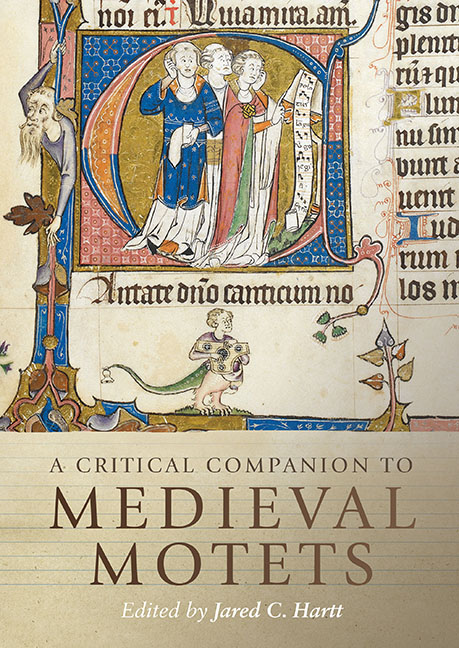Book contents
- Frontmatter
- Dedication
- Contents
- List of Figures
- List of Music Examples
- List of Tables
- List of Contributors
- Preface
- Acknowledgments
- Abbreviations
- Introduction: Approaching Medieval Motets
- 1 The Genre(s) of Medieval Motets
- 2 Origins and Interactions: Clausula, Motet, Conductus
- 3 Tracing the Tenor in Medieval Motets
- 4 Isorhythm
- 5 Notation
- 6 Thirteenth-Century Motet Functions: Views through the Lens of the Portare Motet Family
- 7 A Prism of its Time: Social Functions of the Motet in Fourteenth-Century France
- 8 Motets, Manuscript Culture, Mise-en-page
- 9 Clerics, Courtiers, and the Vernacular Two-Voice Motet: The Case of Fines amouretes / Fiat and the Roman de la poire
- 10 When Words Converge and Meanings Diverge: Counterexamples to Polytextuality in the Thirteenth-Century Mote
- 11 Motets in Chansonniers and the Other Culture of the French Thirteenth-Century Motet
- 12 Building a Motet around Quoted Material: Textual and Musical Structure in Motets Based on Monophonic Songs
- 13 The Duet Motet in England: Genre, Tonal Coherence, Reconstruction
- 14 Materia Matters: Reconstructing Colla/Bona
- 15 Machaut’s Motet 10 and its Interconnections
- 16 A Motet Conceived in Troubled Times: Machaut’s Motet 22
- 17 A Motet Ahead of its Time? The Curious Case of Portio nature/Ida capillorum
- Bibliography of Works Cited
- Select Glossary
- Index of Cited Motets
- General Index
- Studies in Medieval and Renaissance Music
15 - Machaut’s Motet 10 and its Interconnections
Published online by Cambridge University Press: 21 October 2020
- Frontmatter
- Dedication
- Contents
- List of Figures
- List of Music Examples
- List of Tables
- List of Contributors
- Preface
- Acknowledgments
- Abbreviations
- Introduction: Approaching Medieval Motets
- 1 The Genre(s) of Medieval Motets
- 2 Origins and Interactions: Clausula, Motet, Conductus
- 3 Tracing the Tenor in Medieval Motets
- 4 Isorhythm
- 5 Notation
- 6 Thirteenth-Century Motet Functions: Views through the Lens of the Portare Motet Family
- 7 A Prism of its Time: Social Functions of the Motet in Fourteenth-Century France
- 8 Motets, Manuscript Culture, Mise-en-page
- 9 Clerics, Courtiers, and the Vernacular Two-Voice Motet: The Case of Fines amouretes / Fiat and the Roman de la poire
- 10 When Words Converge and Meanings Diverge: Counterexamples to Polytextuality in the Thirteenth-Century Mote
- 11 Motets in Chansonniers and the Other Culture of the French Thirteenth-Century Motet
- 12 Building a Motet around Quoted Material: Textual and Musical Structure in Motets Based on Monophonic Songs
- 13 The Duet Motet in England: Genre, Tonal Coherence, Reconstruction
- 14 Materia Matters: Reconstructing Colla/Bona
- 15 Machaut’s Motet 10 and its Interconnections
- 16 A Motet Conceived in Troubled Times: Machaut’s Motet 22
- 17 A Motet Ahead of its Time? The Curious Case of Portio nature/Ida capillorum
- Bibliography of Works Cited
- Select Glossary
- Index of Cited Motets
- General Index
- Studies in Medieval and Renaissance Music
Summary
CHOICE OF TENOR
THE MUSICAL FOUNDATION of a motet is a tenor that underpins the structure with a melody usually taken from chant. Egidius de Murino prescribes that the tenor should first be taken from an antiphon, responsory or other chant, and that the words should concord with the materia about which the motet is to be made. While the tenor is the musical foundation, it is not the only building block; Egidius at least implies that the verbal content of the upper parts has already been decided, whether or not the texts, or indeed any musical features, have been worked out in detail. This substance (materia) precedes and determines the choice of tenor. In nearly all of Machaut's motets (and in many by other composers) the words and chant excerpt of the tenor are not those of the beginning of the chant, often pointing up a deliberate choice to isolate a word or phrase especially suited to the – perhaps already planned – upper-part texts. This has often made it harder (and sometimes impossible) to identify the source chant, especially if it is unlabeled.
But it is not only in the disposition of the tenor as a skeleton or ground-plan for the motet that the tenor shapes its musical material. Machaut clearly also chose his chant excerpt for its musical qualities, important among them its potential to serve as the grammatical foundation for counterpoint; not only would the composer assess the number of tenor notes for its divisibility into talea units, but also its cadencing potential at tenor rests or talea divisions, especially at the end, at least in the three-part motets. Nearly all of Machaut's three-part motets end with a stepwise descent in the tenor, which serves the final cadence. The exceptions are the three whose tenors are secular melodies (M11, M16, and M20), and whose final ascents would once have formed counterpoint against the songs’ own tenors.
The four four-part motets are also exceptions to final stepwise tenor descent; they all share the tenor role with an essential contratenor (and would thus have been candidates for composition with the aid of a solus tenor). M5 and M23 are the only motets with (interlocking) coloration in tenor and contratenor. The tenor of M21 does make a stepwise cadence, but in M22 and M23 the final stepwise descents are made not by the tenor, but by the contratenor.
- Type
- Chapter
- Information
- A Critical Companion to Medieval Motets , pp. 301 - 320Publisher: Boydell & BrewerPrint publication year: 2018



